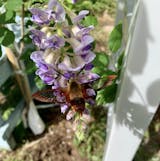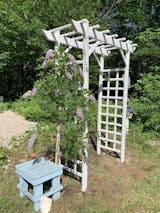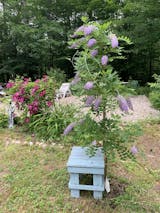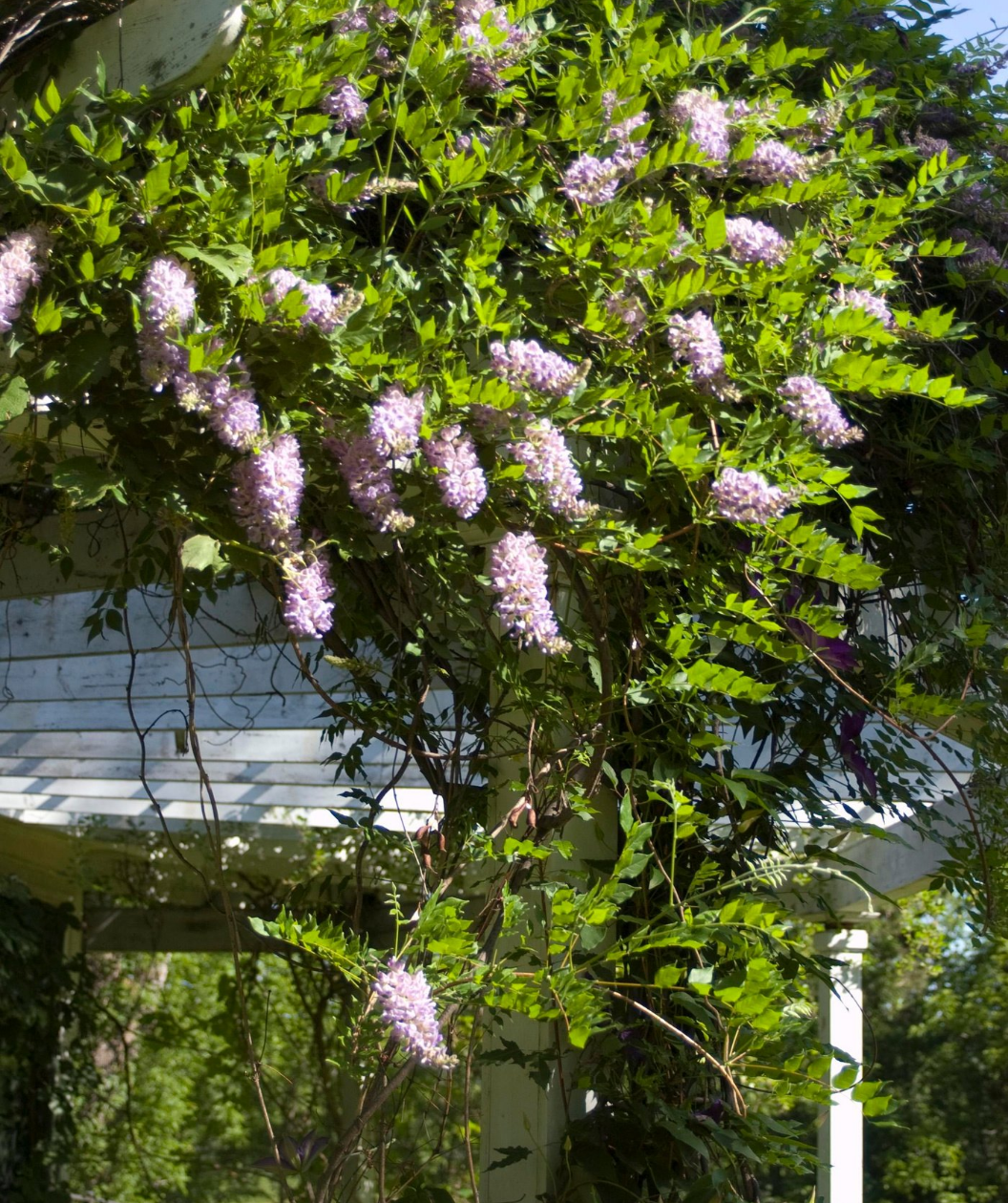



A NEW (TREE) SPIN ON A BELOVED VINE
FEATURES:
- Long, elegant clusters of lavender and white flowers appear in late spring to early summer
- Each delicate flower is lightly fragrant and attracts pollinators
- This native selection of Wisteria has been trained in to a tree form, so plant it near your patio or porch to enjoy its beauty
- Possibility for a second showing of these lovely blooms later in the season
- Hand selected fresh from our grower
- Ships in a plant-safe designed box
Growth Facts
- Hardiness Zone: 5-8
- Mature Height: As Trained
- Mature Width: As Trained
- Exposure: Full Sun
- Spacing: As Desired
A NEW (TREE) SPIN ON A BELOVED VINE
FEATURES:
- Long, elegant clusters of lavender and white flowers appear in late spring to early summer
- Each delicate flower is lightly fragrant and attracts pollinators
- This native selection of Wisteria has been trained in to a tree form, so plant it near your patio or porch to enjoy its beauty
- Possibility for a second showing of these lovely blooms later in the season
- Hand selected fresh from our grower
- Ships in a plant-safe designed box
Growth Facts
- Hardiness Zone: 5-8
- Mature Height: As Trained
- Mature Width: As Trained
- Exposure: Full Sun
- Spacing: As Desired
Why plant Aunt Dee Kentucky Wisteria?
Our Aunt Dee Wisteria will bring a romantic feel to your landscape each spring with its long clusters of lightly fragrant lavender flowers dripping from every branch. If you’ve always loved Wisteria for its dreamy blossoms but were afraid this fast-growing vine would take over your house, we have some good news: this native selection is less rampant than the usual form, and we’ve trained it into a tree so that it can stand on its own. As a bonus, this lovely vine-turned-tree may delight you with a repeat performance of blooms later in the season, too!
Hold your horses! Before you accuse this plant of being the same vine that swallowed up the South (along with Kudzu), take a closer look. This is not one of those rambunctious Asian Wisterias, but a tamer native sort known as “Kentucky Wisteria.” We have trained it to grow in a tree form. This selection was first grown around 50 years ago by Minnesota garden center owner Brad Pederson. That keyword “Minnesota” tells you how cold-hardy it is. And yes, there was a real “Aunt Dee”—Brad’s great-aunt got the honors.
How to use Aunt Dee Kentucky Wisteria in the landscape?
This iconic blooming vine has been trained into a tree form so now you can plant it wherever you want - no trellis necessary! This majestic tree form is covered in bright green foliage and beautiful clusters of light purple flowers that appear in late spring/early summer. Definitely a specimen that you want to show off in your garden.
Planting Zones
Hardiness Zones: 5-8
How To Plant Aunt Dee Kentucky Wisteria
This species of Wisteria can be found growing naturally all along the Southern half of the Mississippi River Valley. Consequently, it will exist happily in that low spot in your yard that often gets a little squishy. Higher ground is good, too.
How To Water
They require keeping the soil moist (not too wet) after initial planting. Once established, they are more tolerant of drought conditions, reducing your hand-watering responsibilities.
How To Fertilize
During fall, feed your Wisteria Bower & Branch Elements Fertilizer once a year for about the first 3 or 4 years - this will give your tree all the nutrients it needs.
How To Prune
While this version of Wisteria is not as fast-growing as others, it will still create a lot of foliage over the course of the growing season. Don’t be afraid to give it some tough love with the clippers if it starts to get out of bounds.
How Does Shipping Work?
Bower & Branch Trees, the real BIG trees, don’t fit in a box! Our big trees, sizes XL and bigger, require expert delivery and care, that means our extra-large trees are shipped on Bower & Branch trucks. We are the only ones who know how to ship our big and bigger trees and plants with tender loving care. We deliver your trees and plants directly to you. Ask Bower & Branch about planting services – we'd be happy to assist in installation.
*For Big trees and Shrubs, Size XL and bigger: Review our Seasonal Shipping Timelines and Policy here.
Your trees and plants are grown across the United States at various Bower & Branch Growers. Depending on your location, your plant orders may be shipped from various locations. Please expect orders with multiple items to be delivered over a number of days as a result. Orders made up of numerous items or selections will not arrive at your home on the same day.
Shipping Delays:
From time to time, Bower & Branch Growers may determine to delay order shipment based on various factors for plant health. Weather in your region, as well as, where your plants are grown, is always considered when shipping. Extreme weather conditions may delay some or all of your order. Bower & Branch allows our Growers to make final shipping decisions based solely to benefit your trees and plants’ health and success.
How Does Sizing Work?
The size of our trees have nothing to do with the container size like you may find elsewhere–big doesn't mean just height - it’s also vigor, age, and overall health. Other online retailers are going to tell you that a plant is a seven gallon, that means nothing to your tree or plant (or you.)
Our trees for sale online are graded on large, x-large, and even bigger sizes. This is because our trees are sized by their age—the higher the letter, the more mature the tree. The age determines the trees’ overall height, size of the trunk and the overall branch density.
All of these characteristics are what you should be looking for when choosing a tree for immediate impact and instant curb appeal. Our extra-large tree and plant sizes are sure to wow you and your neighbors!
See the size guides below.






Our Guarantees
3-YEAR-TREE GUARANTEE:
Bower & Branch offers a Three-Year Tree Guarantee on all of our trees, sizes X-Large and up. Only the finest and the most experienced growers are awarded the opportunity to grow for Bower & Branch, so we offer the best guarantee available.
If your tree(s) should fail for any reason during the three-year guarantee period, you will receive an online gift card in the amount that you originally spent on the tree.* You can then use this online gift card for any Bower & Branch Purchase.
* Bower & Branch provides online gift cards in the amount of the original purchase price of the tree(s). The amount does not include any additional costs such as delivery, planting, tax, or any other products or services. Online gift cards can be applied towards any Bower & Branch purchase on BowerandBranch.com and have no expiration dates. Bower & Branch does not guarantee tree replacement or availability of any desired product at any time. Cash refunds are not offered. Bower & Branch requires that all original tags and receipts are present when a guarantee request is initiated. The Bower & Branch Three-Year Guarantee only applies to plant material that has been planted in the ground. Container plantings are NOT covered.
At Bower & Branch, we do our best to honor all guarantee fulfillment requests to ensure customer satisfaction. However, we reserve the right to refuse the request if the required guarantee steps were not satisfied. Bower & Branch also reserves the right to deny any guarantee fulfillment request that is made as a result of animal damage, problems with plant hardiness and zone issues, or acts of nature (snow storms, hurricanes, and similar).
Reach out to a Plant Whisperer with any questions:
- Email: plantwhisperers@bowerandbranch.com
- Phone: 866-873-3888
- Or via Online Chat







